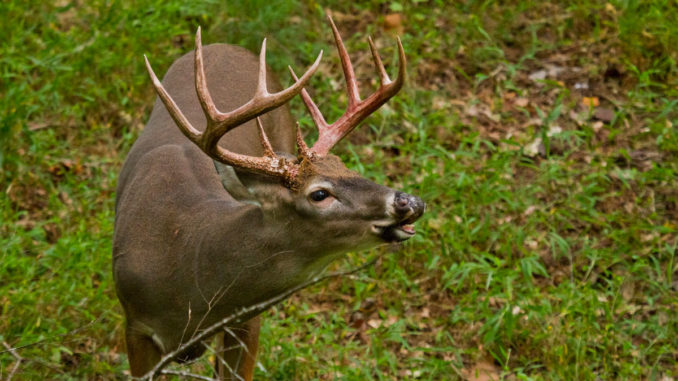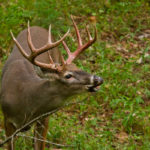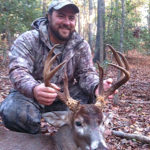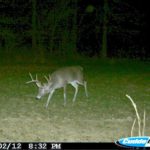
Hunting acorns and food plots are still among the best strategies for taking an October buck
Legislative changes in deer-hunting regulations over the past two seasons have breached the great divide between hunters in the Upstate and those in the Midlands and Lowcountry.
Now, you can hunt deer over bait anywhere on private land in South Carolina.
Regardless of which side of the debate you fall on, the fact is that baiting will now become a factor in how hunters pattern deer in Game Zones 1 and 2. Will Montgomery, owner of Carolina Farm & Wildlife Supply in Pauline, said your danged if you do and danged if you don’t.
“What I hope to see this year is that the people in the area who have been planting food plots will recognize that a food plot, management-wise, is 10 times better than a bag of corn,” he said. “A food plot will feed the herd for an extended period of time. A bag of corn will feed a few deer for a very short period of time.”
Montgomery chose to remain neutral in the debate, since his store sells both food-plot supplies and bagged corn. He’s more interested in Upstate hunters learning to integrate baiting into the whole equation than using it as a catch-all.
“I’m not opposed to baiting,” he said. “I think there is room for both and a need for it. I definitely think there is a strong need for food plots. If you want to just kill deer for meat, then go buy a bag of corn. If you want to try to create quality habitat with a quality herd, it takes a year-round feeding regimen that includes food plots, deer minerals and supplemental feeding with a high-protein deer pellet. It requires serious management to grow a deer you’ll be proud to put on the wall.”
“But there is a time and place for corn, especially for a bowhunter like me,” he said, laughing. “We need all the help we can get.”
Some of the best help hunters can get is from trail cameras, Montgomery said, in part because of the difference between the habitat in the rolling hills of Upstate counties and the flat ground of the Lowcountry. It changes the way a hunter can and should pattern deer, especially one he’d like to kill, and it also changes the way hunters should scout.
“We have more dense forests, which is a different type of habitat for deer,” Montgomery said. “It definitely makes it trickier to hunt a pine stand than a 600-acre corn field. Flat ground tends to be easier to scout. You can see the deer (farther away) or you can pattern the deer easier just by glassing fields, which is what a lot of the (Lowcountry) guys are actually doing in August rather than just hunting deer. But up here, you really can’t glass the woods effectively to pattern deer.
“You definitely need cameras,” he said. “Try to be smart. I was told to not try to think like a deer, because if you try to think like a deer, you’re never going to kill one. But certain places definitely make better areas for deer habitat. That’s what you want to be monitoring.”
Bart Littlejohn, who manages Carolina Farm & Wildlife (864-585-0935) for Montgomery, rarely ventures far from the woods from the time archery season opens on Sept. 15 until at least Halloween. A serious bowhunter, Littlejohn has some unique observations about the deer that call the area where he hunts home.
“Everyone will tell you our rut her is the last of October, first of November,” he said. “People say I’m crazy, but I believe we have a pre-rut scenario that goes on a few days before and a few days after Halloween, but I’m convinced our true rut isn’t until after Thanksgiving.”
Littlejohn said his best two kills in 2012 were mature bucks that were dead on the heels of does. The first was killed Dec. 1 and the second one Dec. 24.
Because he believes the rut is later than most people think, Littlejohn relies much more on acorns than scrapes, rubs or even piles of corn to put him in touch with deer. By Oct. 1, he has pinpointed which oak trees are dropping the most and best acorns, and which deer are showing up to take advantage.
“I use a lot of cameras,” he said. “They go up July 1; I put them around mineral licks so I can get an idea of what we have on our club and check them once a week. Then, as the summer pattern wears off and the bachelor groups start to break up, I’ll rely on maybe just two cameras to locate the better deer or even one specific deer. I drop back to checking those cameras once every two weeks to minimize impact.”
Montgomery is of the same mind. When the acorns start to fall, deer will stop whatever they’re doing — grazing food plots, eating corn piles, whatever — and zero in on those acorns.
“They won’t leave food plot 100 percent, but the activity around my food plots goes down 90 percent,” he said. “When the acorns start dropping up here, I’m going to be on an acorn ridge. That’s where they’re gonna be — at least the does. And you’ve got a chance of the does bringing a buck in with them.”
Montgomery had the best of both worlds going for him when he took a big 11-point buck on Halloween in 2011.
“I had found his sheds the year before under the tree I was sitting in when I killed him,” he said. “He had a rub line running right through the middle of the acorn patch.”
Montgomery was in a tree close to the middle of the stand of oaks when he killed that buck, but he usually likes to set up a stand on the downwind side of the edge of the oaks, depending on the prevailing wind. And he’d like to be on the opposite side of the patch of oaks from the direction he expects the deer to come in. But iff the wind isn’t right, he won’t hunt that stand, but if the wind’s right, that’s as good as it gets.
“It depends a lot on what trees are producing the best acorns, but I’d probably rather be on the edge of the oaks,” he said. “You can get better concealment along the edge than you can right in the middle, and you don’t have to watch 360 degrees around you. You can watch everything happen in front of you.
“I like to have a buck come into the oaks from the other side, because you tend to have more time to get a good shot if he’s eating than if he’s just walking in past you.”
Montgomery will stay with the oaks as long as there’s a good acorn crop on the ground, because the deer won’t change. If the acorns thin out, he’ll either go back to concentrating on food plots or pay more attention to rub lines and scrape lines.
“It depends a lot on how good the acorn crop is,” he said. “We’ve had bumper crops of acorns up here where there were still acorns on the ground the next spring; I killed a turkey one year that was full of acorns.”
Littlejohn said hunters need to decide early on what they intend to do with their doe herd if the desired end result is a trophy buck. He said that you can’t have it both ways.
“The rule on our club is no does killed in food plots before the week of Thanksgiving,” he said. “Even so, you have to be careful about what you’re teaching other deer if you decide to take a doe out in the woods.”
He admits to sometimes taking one doe early on in the season, just to get the monkey off his back, but it’s typically quiet, secluded and away from the eyes of other deer.
“The last thing you want is a bunch of nervous does on your property,” he said. “If they’re spooky, the bucks will be spooky, and that makes the chances of killing that trophy buck even more difficult.”





Be the first to comment